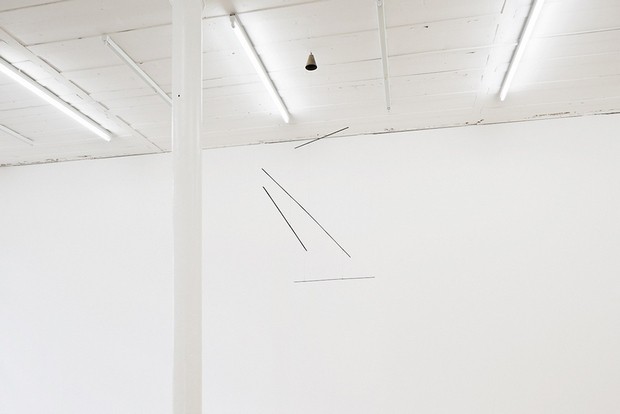Resonanzkatastrophe
Flavio Merlo & Ben Rosenthal
04 Jun - 31 Jul 2016
RESONANZKATASTROPHE
Flavio Merlo & Ben Rosenthal
4 June - 31 July 2016
Curator(s): Balthazar Lovay
In this exhibition, Merlo and Rosenthal develop a singular language through apparently simple objects that hide tensions as critical as they are imbued with dry wit.
Their objects could be described as “autonomous”, in that they refer as little as possible to elements exogenous to their own reality. After all, this mechanical arm and this piece of wall that advance and retreat have no other reasons for being than this repetitive movement.
Although the objects presented are relatively well integrated into Fri Art’s spaces, they are nevertheless not in situ architectural interventions. Each of them could be moved and exist in other exhibition spaces. Similar ambiguities are found within each of the artists’ works: hence the mobiles created from bells never ring, a column blocks the visitor’s path but is pierced by an opening that offers a viewing point, the shutters integrated into Fri Art’s windows will never entirely darken the two rooms in front of which they are placed, and so on.
These different objects, although autonomous, are nevertheless not solitary. Spectators are invited to construct their own investigation into this network of echoes and discreet connections that converse with the Kunsthalle’s spaces. The column resonates with the pillars that support the ceiling but also allows people to observe, through its hole, a stain drawn by the two artists. The linear motor is a kinetic allusion to the two suspended mobiles as well as an echo of the corridor that runs alongside the room in which it is placed.
The two artists disseminate a range of clues and connections, but collecting them does not enable any certainty to be established. This inquiry is revealed to be as futile as the repetitive movement of a section of motorized wall. However, each object displays coherency. The mobile indeed fits the definition but does not particularly fulfill its promises, and the hole in the column does not offer a spectacular view. Why erect an object of this size for such a limited effect? The orifice directs the gaze to the drawing of a stain that, in any case, can be seen more clearly when we come closer to it. Although nothing is truly illogical or irrational, everything seems perfectly absurd. Or, to put it in another way, these objects, movements and infinite forward-back actions have no other meaning than themselves.
Flavio Merlo & Ben Rosenthal
4 June - 31 July 2016
Curator(s): Balthazar Lovay
In this exhibition, Merlo and Rosenthal develop a singular language through apparently simple objects that hide tensions as critical as they are imbued with dry wit.
Their objects could be described as “autonomous”, in that they refer as little as possible to elements exogenous to their own reality. After all, this mechanical arm and this piece of wall that advance and retreat have no other reasons for being than this repetitive movement.
Although the objects presented are relatively well integrated into Fri Art’s spaces, they are nevertheless not in situ architectural interventions. Each of them could be moved and exist in other exhibition spaces. Similar ambiguities are found within each of the artists’ works: hence the mobiles created from bells never ring, a column blocks the visitor’s path but is pierced by an opening that offers a viewing point, the shutters integrated into Fri Art’s windows will never entirely darken the two rooms in front of which they are placed, and so on.
These different objects, although autonomous, are nevertheless not solitary. Spectators are invited to construct their own investigation into this network of echoes and discreet connections that converse with the Kunsthalle’s spaces. The column resonates with the pillars that support the ceiling but also allows people to observe, through its hole, a stain drawn by the two artists. The linear motor is a kinetic allusion to the two suspended mobiles as well as an echo of the corridor that runs alongside the room in which it is placed.
The two artists disseminate a range of clues and connections, but collecting them does not enable any certainty to be established. This inquiry is revealed to be as futile as the repetitive movement of a section of motorized wall. However, each object displays coherency. The mobile indeed fits the definition but does not particularly fulfill its promises, and the hole in the column does not offer a spectacular view. Why erect an object of this size for such a limited effect? The orifice directs the gaze to the drawing of a stain that, in any case, can be seen more clearly when we come closer to it. Although nothing is truly illogical or irrational, everything seems perfectly absurd. Or, to put it in another way, these objects, movements and infinite forward-back actions have no other meaning than themselves.





